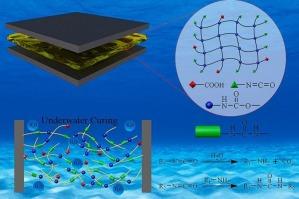具有较强附着力和自固化能力的聚氨酯水下胶粘剂
IF 6.3
2区 化学
Q1 POLYMER SCIENCE
引用次数: 0
摘要
开发高性能水下粘合剂需要克服水化层,确保快速固化,并在恶劣条件下保持稳定性。水通过渗透胶粘剂的结构或干扰固化过程而削弱胶粘剂。本研究提出了一种以环氧树脂、氨基酸和异氰酸酯为原料合成聚氨酯预聚物的简单方法。刚性的双酚A结构和原位CO2生成对于破坏水合层至关重要,而丰富的羰基和氨基提供了强大的粘附性能。不含异氰酸酯的预聚物的搭接剪切强度为4.96 MPa(干),而289 kPa(水)。异氰酸酯掺入的预聚物实现了完全浸没的粘附,持续强度为2.44 MPa。此外,该胶粘剂表现出优异的环境适应性和抗菌性能,其粘接强度分别为2.31 MPa(海水)、2.63 MPa (pH = 3)和2.53 MPa (pH = 11)。这种低成本、坚固耐用的粘合剂有望应用于海洋和生物医学领域。本文章由计算机程序翻译,如有差异,请以英文原文为准。

A polyurethane underwater adhesive with strong adhesion and self-curing capability
Developing high-performance underwater adhesives requires overcoming hydration layers, ensuring rapid curing, and maintaining stability under harsh conditions. Water weakens adhesives by penetrating their structure or interfering with the curing process. This study presents a simple method for synthesizing polyurethane prepolymers from epoxy resin, amino acids, and isocyanate. The rigid bisphenol A structure and in situ CO2 generation are crucial for disrupting hydration layers, while the abundant carbonyl and amino groups provide robust adhesion performance. The prepolymer without isocyanate exhibited a lap shear strength of 4.96 MPa (dry), but only 289 kPa (submerged). The isocyanate-incorporated prepolymers achieved fully submerged adhesion with a sustained strength of 2.44 MPa. Moreover, the adhesive demonstrated exceptional environmental adaptability and antibacterial properties, maintaining bond strengths of 2.31 MPa (seawater), 2.63 MPa (pH = 3), and 2.53 MPa (pH = 11). This low-cost, robust adhesive holds promise for marine and biomedical applications.
求助全文
通过发布文献求助,成功后即可免费获取论文全文。
去求助
来源期刊

European Polymer Journal
化学-高分子科学
CiteScore
9.90
自引率
10.00%
发文量
691
审稿时长
23 days
期刊介绍:
European Polymer Journal is dedicated to publishing work on fundamental and applied polymer chemistry and macromolecular materials. The journal covers all aspects of polymer synthesis, including polymerization mechanisms and chemical functional transformations, with a focus on novel polymers and the relationships between molecular structure and polymer properties. In addition, we welcome submissions on bio-based or renewable polymers, stimuli-responsive systems and polymer bio-hybrids. European Polymer Journal also publishes research on the biomedical application of polymers, including drug delivery and regenerative medicine. The main scope is covered but not limited to the following core research areas:
Polymer synthesis and functionalization
• Novel synthetic routes for polymerization, functional modification, controlled/living polymerization and precision polymers.
Stimuli-responsive polymers
• Including shape memory and self-healing polymers.
Supramolecular polymers and self-assembly
• Molecular recognition and higher order polymer structures.
Renewable and sustainable polymers
• Bio-based, biodegradable and anti-microbial polymers and polymeric bio-nanocomposites.
Polymers at interfaces and surfaces
• Chemistry and engineering of surfaces with biological relevance, including patterning, antifouling polymers and polymers for membrane applications.
Biomedical applications and nanomedicine
• Polymers for regenerative medicine, drug delivery molecular release and gene therapy
The scope of European Polymer Journal no longer includes Polymer Physics.
 求助内容:
求助内容: 应助结果提醒方式:
应助结果提醒方式:


